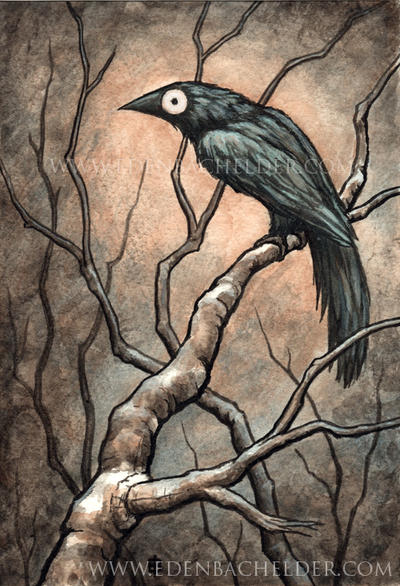 |
| Art: Shmeeden |
“My
curse fall on Sweeney
for his great offense
... it will curse you to
the trees
bird brain among branches”
Based on the earlier Irish folktale Buile Shuibhne, Seamus Heaney's Sweeney Astray tells the story of young king named Sweeney, who was cursed by a saint to become a bird. Much of the story follows Sweeney and the resulting madness endured from the transformation. The association with the bird is meant to bind Sweeney
to an inhuman way of life, and it certainly does so. But the curse also gives Sweeney a bird-like
liberation in flight and song and throughout the story, Sweeney find's solace and identity through poetry and song.
 The story itself (both versions) is a mix of poetry and prose. Interestingly, Sweeney's physical transformation is written in one
stanza and the poetic form of this scene allows images to flicker
between his loss of and liberation from humanity. As his mind turns
away from humanity to become “revolted by the thought of known
places,” he also “dreamed of strange migrations”(9). Similarly
his body rejects human workmanship as “weapons fell from his hands”
but he soon “levitated in a frantic cumbersome motion/like a bird
of the air” (9). Sweeney is thrust from his familiar world of
humanity, but the poetic form highlights his simultaneous acceptance
into a new world. As Sweeney will spend the rest of the tale both
lamenting his past and celebrating his place in the wilderness, this
moment is important in establishing poetry as a means for Sweeney to
understand his place in the world.
The story itself (both versions) is a mix of poetry and prose. Interestingly, Sweeney's physical transformation is written in one
stanza and the poetic form of this scene allows images to flicker
between his loss of and liberation from humanity. As his mind turns
away from humanity to become “revolted by the thought of known
places,” he also “dreamed of strange migrations”(9). Similarly
his body rejects human workmanship as “weapons fell from his hands”
but he soon “levitated in a frantic cumbersome motion/like a bird
of the air” (9). Sweeney is thrust from his familiar world of
humanity, but the poetic form highlights his simultaneous acceptance
into a new world. As Sweeney will spend the rest of the tale both
lamenting his past and celebrating his place in the wilderness, this
moment is important in establishing poetry as a means for Sweeney to
understand his place in the world.
Throughout
Sweeney Astray, poetry shifts from a reflection of Sweeney's
madness to a means to find his identity. Sweeney's madness is derived
not from his current state in the wild, but by continually
remembering his past. Sweeney's early poetry is an outlet
for obsessively reflecting upon his former “good luck and kingship”
(18) and for lamenting his fall “from noble heights” (16). But poetry
soon becomes a means to explore and praise his current condition. He
begins his exile by proclaiming:
I am the madman of Glen Bolcain,
wind scourged, stripped
like a winter tree
clad in black frost
and frozen snow (17).
The
poetic form, calling for metaphor, prompts Sweeney to compare his
deprived state to that of a winter tree. Although Sweeney does so in
order to describe his condition as miserable, we see the beginnings
of Sweeney using poetry to discover his relationship with nature.
Even in initially identifying himself as a madman, he identifies his
tie to the land “of Glen Bolcain.” Though this early poem
associates nature more with his state of madness, Sweeney eventually
uses poetry to identify the tranquility found in nature.
 |
| Art kluzehellion |
Sweeney's
“ bird brain” ultimately allows him to both physically and
poetically leave his former world and accept a new identity in the
wild. In the middle of his chase with the hag, Sweeney is so moved by
hearing a hunted stag in the woods that he makes “a poem in which
he praised aloud all the trees of Ireland, and rehearsed some of his
own hardships and sorrows” (36). This poem, the longest in the
tale, is not the bitter reflection of the past of his former poetry,
but a form of catharsis in which he praises nature and reveals his
affinity with living things, stating that the bellowing stag
”startles my heartstrings”(36) and “the alder is my
darling”(37). Sweeney's former life is both removed and replaced as
he crowns the birch tree “queen of trees”(38) and proclaims his
preference of the“rhapsody of blackbirds /to the garrulous
blather/of men and women” (43). No doubt, this sort of exile and
exclusion from the social world is what was meant to send Sweeney
mad. It is however, in his exile that Sweeney turns to poetry, and in
using poetry to find a peace and kinship with nature, ultimately
finds peace within himself. For in nature, “what enmity is
possible?”(62).
